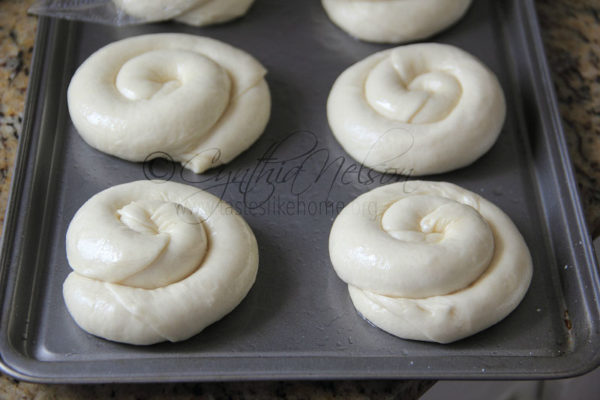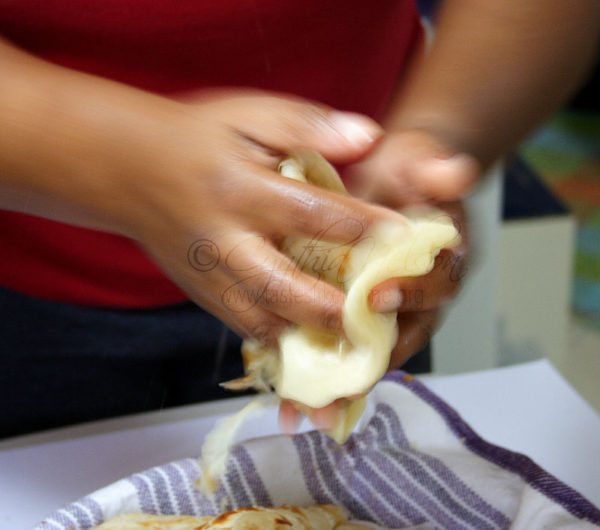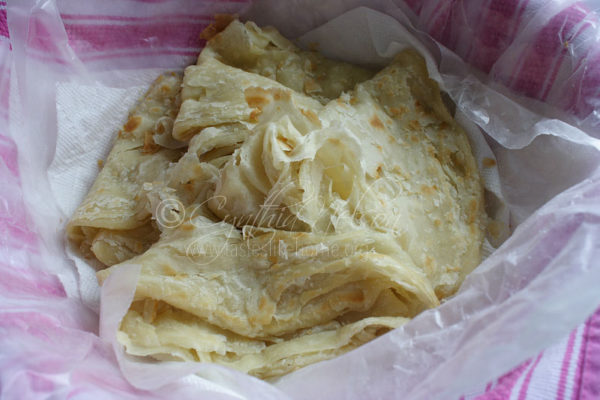A couple of weeks ago, in response to my column on fish curry, a very good friend of mine insisted that the roti for his curry must be hand-clapped. Such a statement might lead one to wonder – is there any other way? Well, yes. The other methods are – pounded (wrapped in a kitchen towel and bashed a few times with a rolling pin), shaken (put into a jug with a cover and energetically moved up and down) or (and this is the closest to hand-clapped) slapped together with two flat wooden spatulas, called dablas.
Each method alters not only the appearance of the paratha but it also impacts the texture. The pleasure of eating paratha roti is about the texture. For me, it is about tearing at soft, light, leafy layers of roti, flimsily held together. It is about dragging pieces of torn roti through the sauce of fragrant curries and draping it over morsels of meat to transport to my mouth; daubing at fried pumpkin, callaloo, baigan choka etc. Therefore, the best method (for me) to facilitate this kind of enjoyment is with hand-clapped roti. I am not knocking (no pun intended) the other methods because I would not refuse a good paratha but hand-clapped is how I like my paratha finished.
Pounding the roti with a belna (rolling pin) when it is done cooking, results in it being broken up into large and small pieces. Shaking it in an enclosed jug simply crumbles the roti. These methods do not release the layers of the roti briefly suspended by hot air as it leaves the tawah. Slapping the roti with two dabla(s), mimicking the clapping of the roti by hand is not a bad alternative to clapping; it releases some of the layers leaving much of the roti intact. This is good for commercial purposes and it is the practice used in Trinidad and Tobago. However, why hand clapping of the paratha wins is because the hands provide more surface area to come in contact with the roti, the hands can alter the strength with which the roti is clapped – gently or firmly. The hands “know” when the roti has been clapped enough to release the layers. The hands know.
I have been asked many times why there is such fuss about the ‘finish’ of paratha roti. To explain, I often draw reference to puff pastry. Puff pastry is a light flaky pastry that when baked results in several layers due to the layering of butter between the dough, folding and rolling it several times before resting and chilling. Similarly, the paratha roti can be thought of as a type of pasty – the rubbing of ghee or oil on the dough and rolling it upon itself to form layers when cooked. Just like butter that melts and is leavened by the water turning into steam during the baking process of puff pastry, the baking powder, in combination with the layered ghee/oil in the dough facilitates the roti puffing up, creating steam that releases the layers when the cooked roti is hand clapped. And just like puff pastry, paratha roti is an involved process and takes time to make with resting periods between stages. So, that is what all the fuss is about.
One, if not the main reason the pounding and shaking of paratha took hold, is fear of the heat and stinging of the hands to clap the roti immediately upon removing it from the hot cooking pan. I most certainly do not fault or judge anyone for taking these measures. It is a labour of love for someone to make hand-clapped roti.
My food-in friend, whom I referred to at the top of this column, is, as we would say, spile, demanding his hand-clapped roti. I say that anyone demanding hand-clapped roti must be willing to help with the clapping. What about you? How do you like your paratha roti – hand-clapped? Pounded? Shaken?
Cynthia












